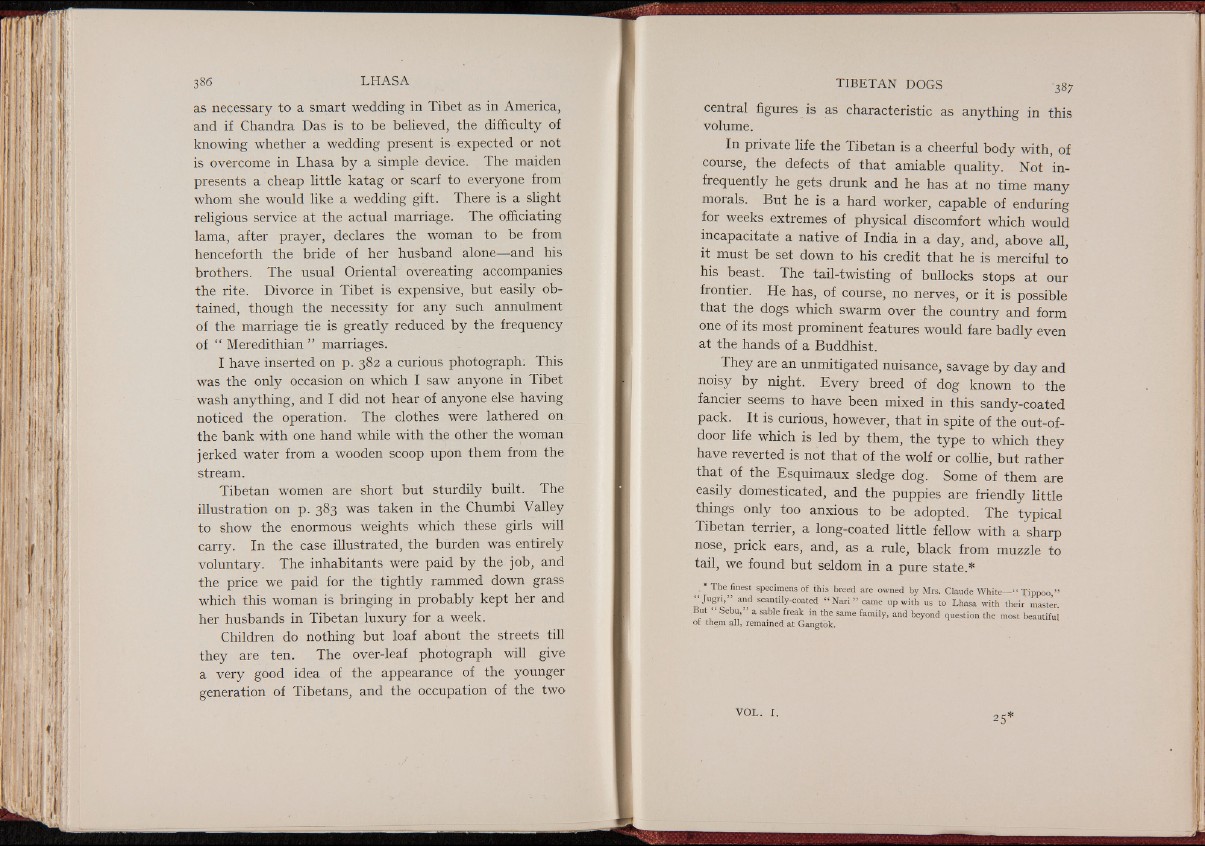
as necessary to a smart wedding in Tibet as in America,
and if Chandra Das is to be believed, the difficulty of
knowing whether a wedding present is expected or not
is overcome in Lhasa by a simple device. The maiden
presents a cheap little katag or scarf to everyone from
whom she would like a wedding gift. There is a slight
religious service at the actual marriage. The officiating
lama, after prayer, declares the woman to be from
henceforth the bride of her husband alone— and his
brothers. The usual Oriental overeating accompanies
the rite. Divorce in Tibet is expensive, but easily obtained,
though the necessity for any such annulment
of the marriage tie is greatly reduced by the frequency
of “ Meredithian ” marriages.
I have inserted on p. 382 a curious photograph: This
was the only occasion on which I saw anyone in Tibet
wash anything, and I did not hear of anyone else having
noticed the operation. The clothes were lathered on
the bank with one hand while with the other the woman
jerked water from a wooden scoop upon them from the
stream.
Tibetan women are short but sturdily built. The!
illustration on p. 383 was taken in the Chumbi Valley
to show the enormous weights which these girls will
carry. In the case illustrated, the burden was entirely
voluntary. The inhabitants were paid by the job, and
the price we paid for the tightly rammed down grass
which this woman is bringing in probably kept her and
her husbands in Tibetan luxury for a week.
Children do nothing but loaf about the streets till
they are ten. The over-leaf photograph will give
a very good idea of the appearance of the younger
generation of Tibetans, and the occupation of the two
central figures is as characteristic as anything in this
volume.
In private life the Tibetan is a cheerful body with, of
course, the defects of that amiable quality. Not infrequently
he gets drunk and he has at no time many
morals. But he is a hard worker, capable of enduring
for weeks extremes of physical discomfort which would
incapacitate a native of India in a day, and, above all,
it must be set down to his credit that he is merciful to
his beast. The tail-twisting of bullocks stops at our
frontier. He has, of course, no nerves, or it is possible
that the dogs which swarm over the country and form
one of its most prominent features would fare badly even
at the hands of a Buddhist.
They are an unmitigated nuisance, savage by day and
noisy by night. Every breed of dog known to the
fancier seems to have been mixed in this sandy-coated
pack. It is curious, however, that in spite of the out-of-
door life which is led by them, the type to which they
have reverted is not that of the wolf or collie, but rather
that of the Esquimaux sledge dog. Some of them are
easily domesticated, and the puppies are friendly little
things only too anxious to be adopted. The typical
Tibetan terrier, a long-coated little fellow with a sharp
nose, prick ears, and, as a rule, black from muzzle to
tail, we found but seldom in a pure state.*
1 * specimens of this breed are owned by Mrs. Claude White— “ Tippoo,”
“ Jugn,” and scantily-coated “ N a r i” came up with us to Lhasa with their master.
But “ Sebu,” a sable freak in the same family, and beyond question the most beautiful
of them all, remained at Gangtok.
VOL. I.
25*